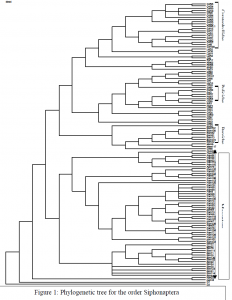Alison Swindle and Dr. Michael F. Whiting, Zoology
Fleas are laterally compressed, wingless insects with small helmet shaped heads, and mouthparts specialized for feeding on the blood of their hosts. These morphological specializations make it possible for fleas to be entirely ectoparasitic, but they also make it difficult to find distinguishing characters on which to base taxonomy above the generic level (Holland, 1964). The highly derived state of flea morphology has resulted in questionable classification within the order, and lack of solid support for any group as the sister taxon to fleas. To this point there has been no molecular study that has considered fleas below the ordinal level. The purpose of this study was to collect a large body of molecular data from a wide sampling of fleas in order to investigate the phylogeny within the order Siphonaptera, and their relationship to other insect orders.
The use of DNA sequence data from multiple gene regions provides independent data sets with which a phylogeny may be inferred. To obtain molecular data, DNA is extracted from the tissues of fleas and subjected to the Polymerase Chain Reaction (PCR). PCR is a process by wich a particular region of DNA can be selectively amplified or duplicated many times. After amplification the desired product is purified and subjected to cycle sequencing which labels the DNA with flourescent dyes. The labeled DNA is then analyzed by the ABI 377 automated sequencer. The result is an electronic output of the sequence of the desired region of DNA.
Sequences were generated from 18S and 28S ribosomal DNA, elongation factor-1alpha (nuclear gene), and cytochrome oxidase II (mitochondrial gene) for 149 specimens. Independent and combined analyses were performed on these data sets to investigate relationships within Siphonaptera as well as the relationship of Siphonaptera to other insect orders, specifically Mecoptera (scorpion flies). The resulting relationships are depicted in the form of a cladogram (see figure 1), which represents the evolutionary history and relationships of fleas. The results support the surprising conclusion that fleas are nested within the order Mecoptera, and are sister group to the snow fleas (Boreidae). Within Siphonaptera, representatives for 10 of the 16 families are present, but only two of the ten families are monophyletic (forming a group) while the other eight are poorly supported. This is not unexpected, and emphasizes the need for the joint study of molecular and morphological data in order to revise the present classification within Siphonptera.

